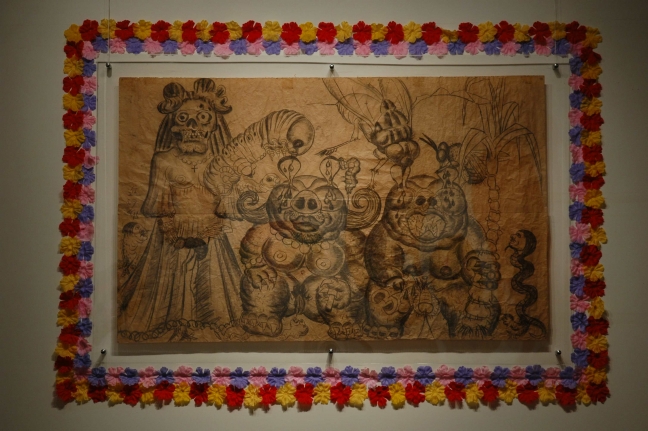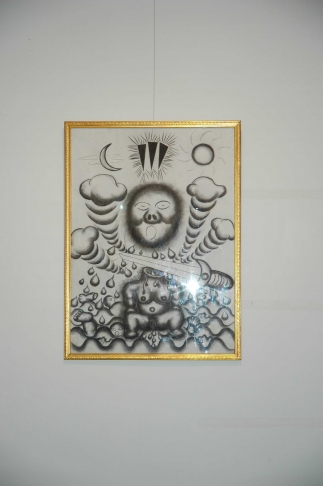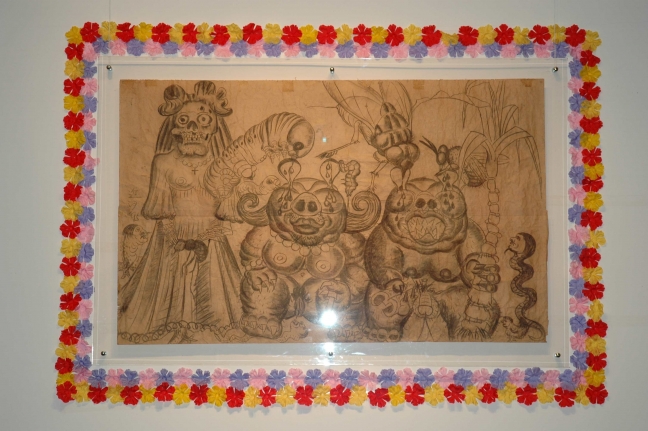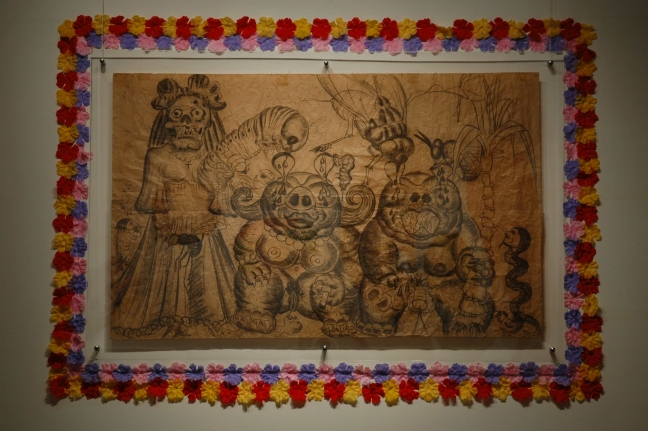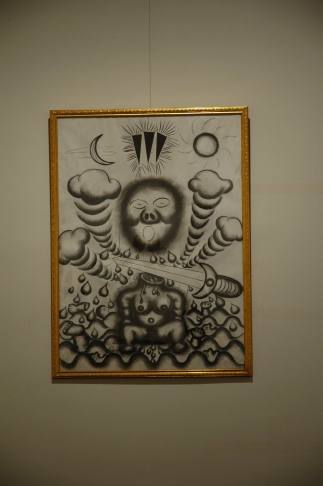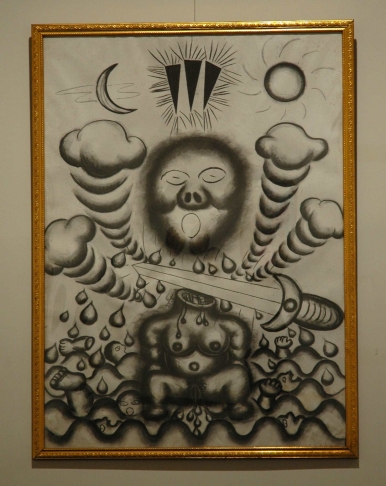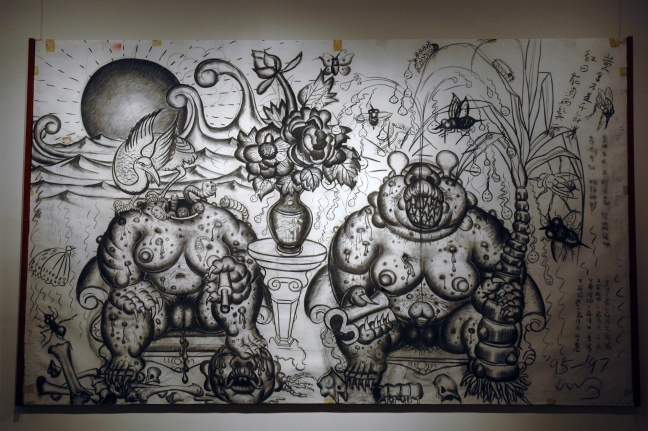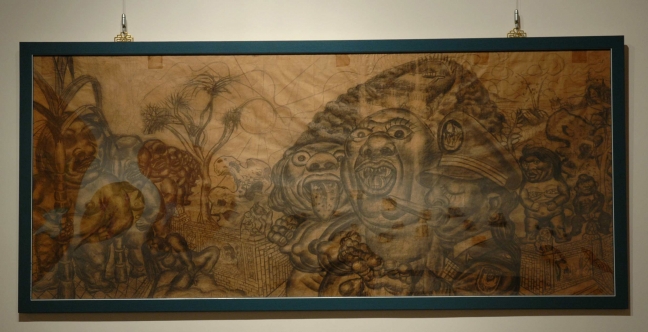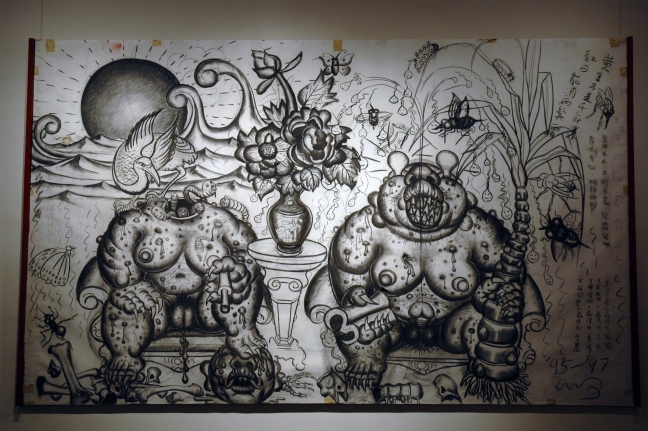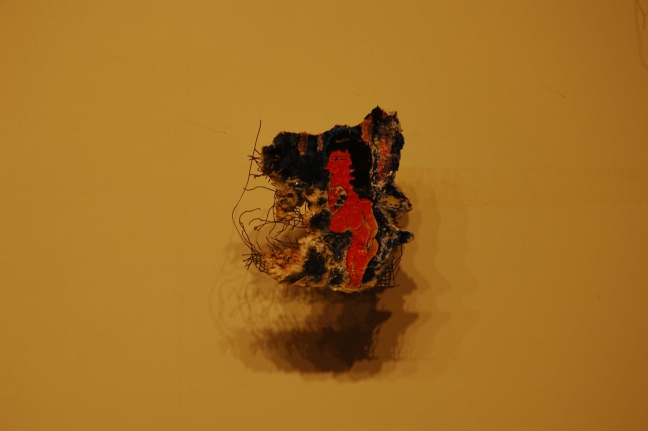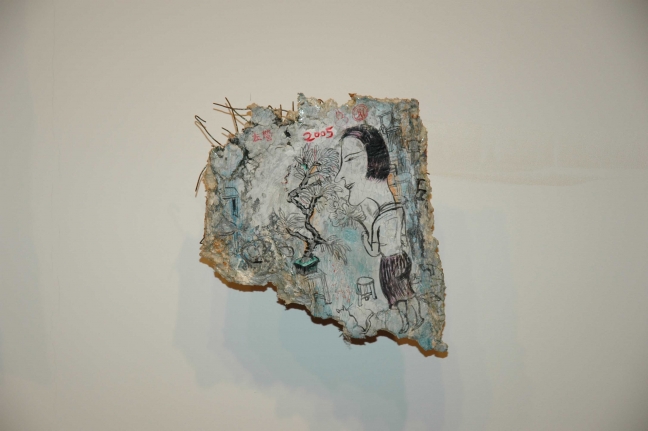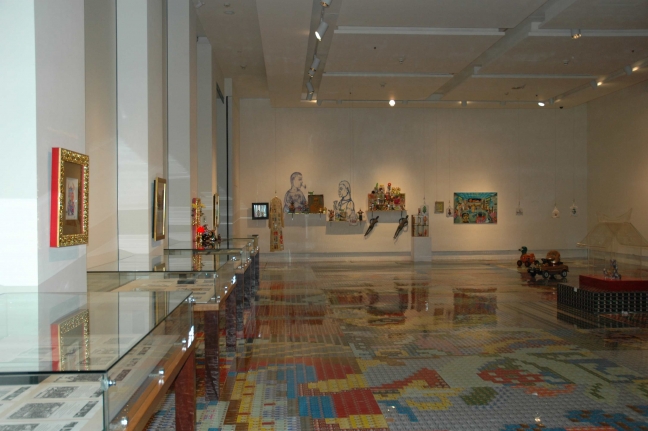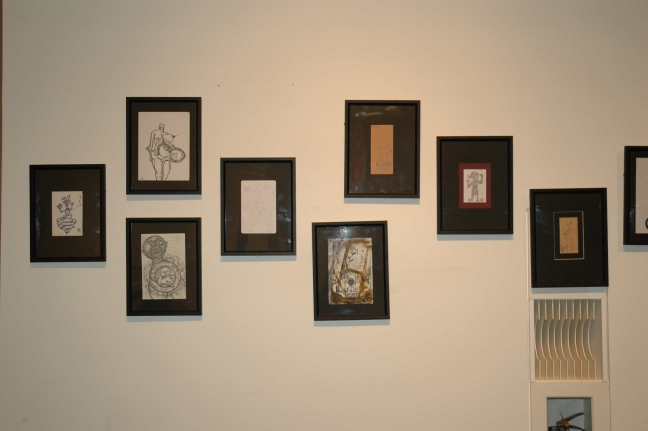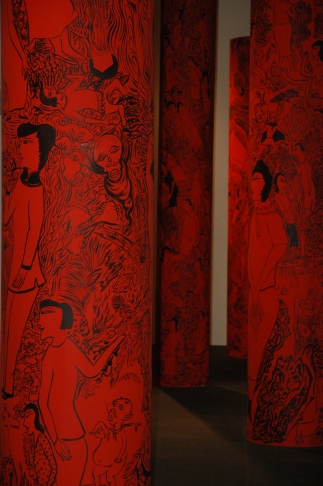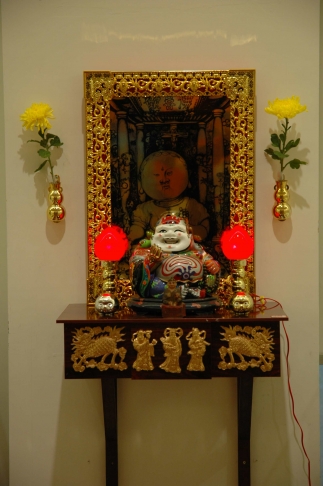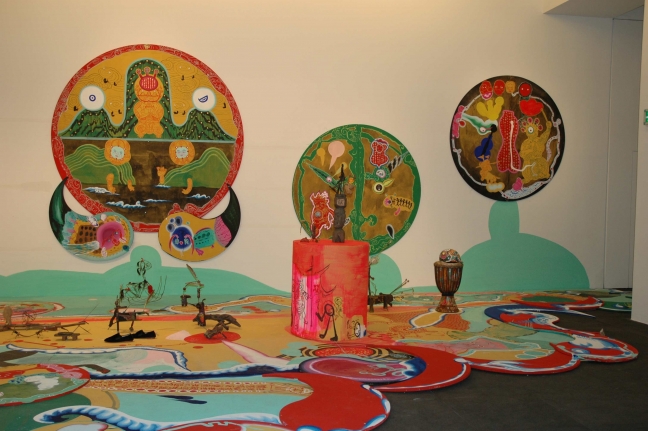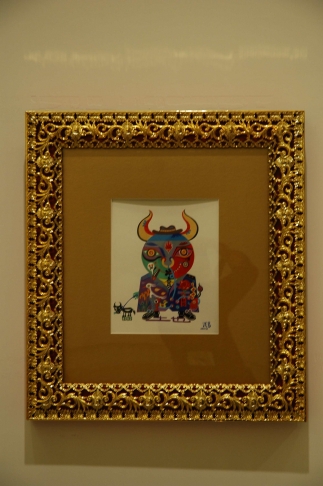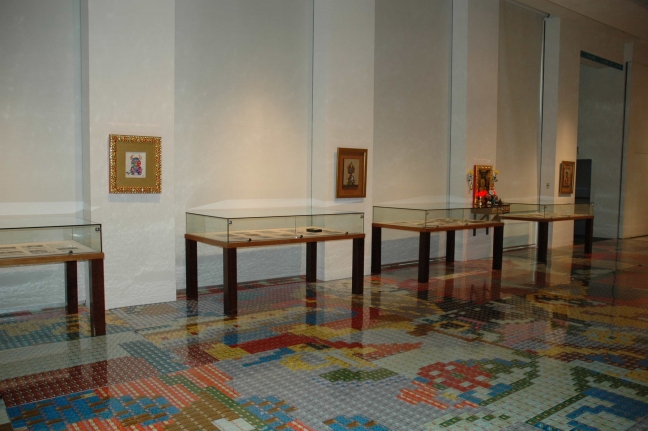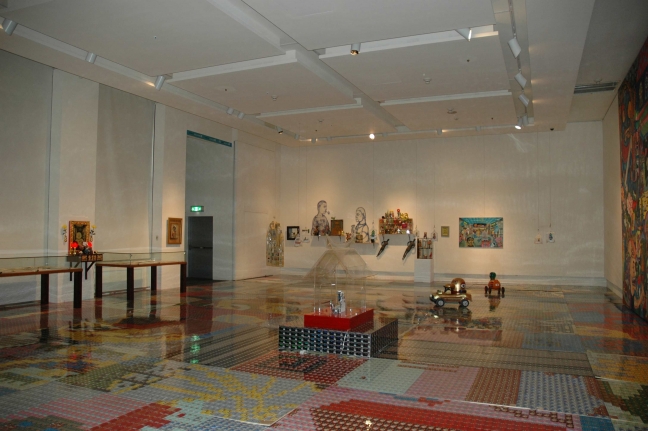“Wu Xing, Wu Xing: earthly and distinctive flowers and grass”
2005.12.16~2006.02.10
09:00 - 17:00
Wu Xing, Wu Xing: earthly and distinctive flowers and grass” From 16th December 2005 onwards, the
Wu Xing (Five Elements), Wu Xing (Five Forms)” Exhibition will be touring from Kaohsiung Museum of Fine Arts to Kuandu Museum of Fine Arts(KdMoFA). The exhibition will not only be displayed in a new environment, but also be given a different appearnce. This exhibition invited 5 Taiwanese artists, including Huang Chin-Ho, Li Ming-Tse, Hong Yi, Li Jiun-Yang, and Huang Po-Chih. These artists combined their recent paintings and three-dimensional works, adjusted specially for Kuandu Museum to present the concept of installation art. They intend to create a new space for dialogue between artists and spectators. Another motivation of this exhibition was to present this series of outstanding works in the form of
Earthly and distinctive flowers and grass” to participate in the
2005 Kuandu Flower Festival” and to offer an opportunity for the general public to witness the energy and livelihood of Taiwanese contemporary art. This five artists spent a long time observing the condition and phenomenon of Taiwanese social culture. Their extravagant artwork stemmed from the lively and dynamic Taiwanese common culture. Since most of them were not academically trained, it is particularly meaningful that Taipei National University of the Arts invited them to participate in an exhibition in the academic environment. Taipei National University of the Arts is an art university without border. The University not only aims at educating and producing the elites in society, but also actively hosts series of activities, in the hope of opening the doors of the university to the general public and absorbing the best from our multi-disciplinary world. Like the Kuandu Flower Festivals, which has been hosted in the University for several years, these activities provide a space and possibility for professional artists to cooperate with private sectors to produce creative works at the campus. In the exhibition of
Wu Xing, Wu Xing”, when the exuberant cultural elements in Taiwan are absorbed, transformed, and created in the form of unique artistic images by five genuinely local painters. These works can not only find many admirers in the audience, but also offer an example for the world outside the academic circle to reflect and to compare.
Wu Xing, Wu Xing” exhibition was the first theme exhibition, produced by Li Jiun-Chien, the newly appointed Director of Kaohsiung Museum of Fine Arts. From the surface, one can see the recent hot issue about
Tai-Ke” (a slang to call Taiwanese) is not as constructive as this exhibition, which positively recognized special cultural values in Taiwan. This dynamic culture fertilizes this land to create extravagant artistic fruits. The five artists not only proved the energy and dynamics of Taiwanese culture with their work, but also call back our memories of the history of this island. The traditional concept of the Five Elements divide everything in the world into five categories: gold, wood, water, fie and earth, which co-exist with each other. Wu Xing also symbolizes five directions, each with different symbolism. Among them: East belongs to wood; green. Wood can brow, symbolizes hard working, self-fulfilling and the duty to propagate. West belongs to gold; white. Gold can cut, symbolizes the ability to develop and to invade, aggressive and revolutionary. South belongs to fire; red. Fire can burn, symbolizes clever and creative, passionate and adventurous. North belongs to water; black. Water can flow, symbolizes freedom and the ability to adjust one’s self to the environment. Central belongs to earth; yellow. Earth is most stable and is the center of Wu Xing. It is the foundation of everything. Because earth can cover water, transform fire into its own energy, hide/bury gold, and fertilize wood. Earth looks most conservative and most restricted by space among the five elements, but it is most compatible to everything. Our ancestors believe, if people can be combined with earth, using it as its foundation and gets help from every side, this is the first step to build up one’s subjectivity. Looking from this angle, this exhibition employs the concept of
Wu Xing, Wu Xing” to define this team of five artists. This not only present their common earthly characteristics, but also recognizes each of their artistic potentials from different area in society. When visiting this exhibition, we can experience in these artworks the five elements outlined by Director Li: commoner’s life, social reality, rustic images, complicated layers of images, tropical condition, were arranged and managed with different combination by the five artists.
Wu Xing, Wu Xing: earthly and distinctive flowers and grass” From 16th December 2005 onwards, the
Wu Xing (Five Elements), Wu Xing (Five Forms)” Exhibition will be touring from Kaohsiung Museum of Fine Arts to Kuandu Museum of Fine Arts(KdMoFA). The exhibition will not only be displayed in a new environment, but also be given a different appearnce. This exhibition invited 5 Taiwanese artists, including Huang Chin-Ho, Li Ming-Tse, Hong Yi, Li Jiun-Yang, and Huang Po-Chih. These artists combined their recent paintings and three-dimensional works, adjusted specially for Kuandu Museum to present the concept of installation art. They intend to create a new space for dialogue between artists and spectators. Another motivation of this exhibition was to present this series of outstanding works in the form of
Earthly and distinctive flowers and grass” to participate in the
2005 Kuandu Flower Festival” and to offer an opportunity for the general public to witness the energy and livelihood of Taiwanese contemporary art. This five artists spent a long time observing the condition and phenomenon of Taiwanese social culture. Their extravagant artwork stemmed from the lively and dynamic Taiwanese common culture. Since most of them were not academically trained, it is particularly meaningful that Taipei National University of the Arts invited them to participate in an exhibition in the academic environment. Taipei National University of the Arts is an art university without border. The University not only aims at educating and producing the elites in society, but also actively hosts series of activities, in the hope of opening the doors of the university to the general public and absorbing the best from our multi-disciplinary world. Like the Kuandu Flower Festivals, which has been hosted in the University for several years, these activities provide a space and possibility for professional artists to cooperate with private sectors to produce creative works at the campus. In the exhibition of
Wu Xing, Wu Xing”, when the exuberant cultural elements in Taiwan are absorbed, transformed, and created in the form of unique artistic images by five genuinely local painters. These works can not only find many admirers in the audience, but also offer an example for the world outside the academic circle to reflect and to compare.
Wu Xing, Wu Xing” exhibition was the first theme exhibition, produced by Li Jiun-Chien, the newly appointed Director of Kaohsiung Museum of Fine Arts. From the surface, one can see the recent hot issue about
Tai-Ke” (a slang to call Taiwanese) is not as constructive as this exhibition, which positively recognized special cultural values in Taiwan. This dynamic culture fertilizes this land to create extravagant artistic fruits. The five artists not only proved the energy and dynamics of Taiwanese culture with their work, but also call back our memories of the history of this island. The traditional concept of the Five Elements divide everything in the world into five categories: gold, wood, water, fie and earth, which co-exist with each other. Wu Xing also symbolizes five directions, each with different symbolism. Among them: East belongs to wood; green. Wood can brow, symbolizes hard working, self-fulfilling and the duty to propagate. West belongs to gold; white. Gold can cut, symbolizes the ability to develop and to invade, aggressive and revolutionary. South belongs to fire; red. Fire can burn, symbolizes clever and creative, passionate and adventurous. North belongs to water; black. Water can flow, symbolizes freedom and the ability to adjust one’s self to the environment. Central belongs to earth; yellow. Earth is most stable and is the center of Wu Xing. It is the foundation of everything. Because earth can cover water, transform fire into its own energy, hide/bury gold, and fertilize wood. Earth looks most conservative and most restricted by space among the five elements, but it is most compatible to everything. Our ancestors believe, if people can be combined with earth, using it as its foundation and gets help from every side, this is the first step to build up one’s subjectivity. Looking from this angle, this exhibition employs the concept of
Wu Xing, Wu Xing” to define this team of five artists. This not only present their common earthly characteristics, but also recognizes each of their artistic potentials from different area in society. When visiting this exhibition, we can experience in these artworks the five elements outlined by Director Li: commoner’s life, social reality, rustic images, complicated layers of images, tropical condition, were arranged and managed with different combination by the five artists.

